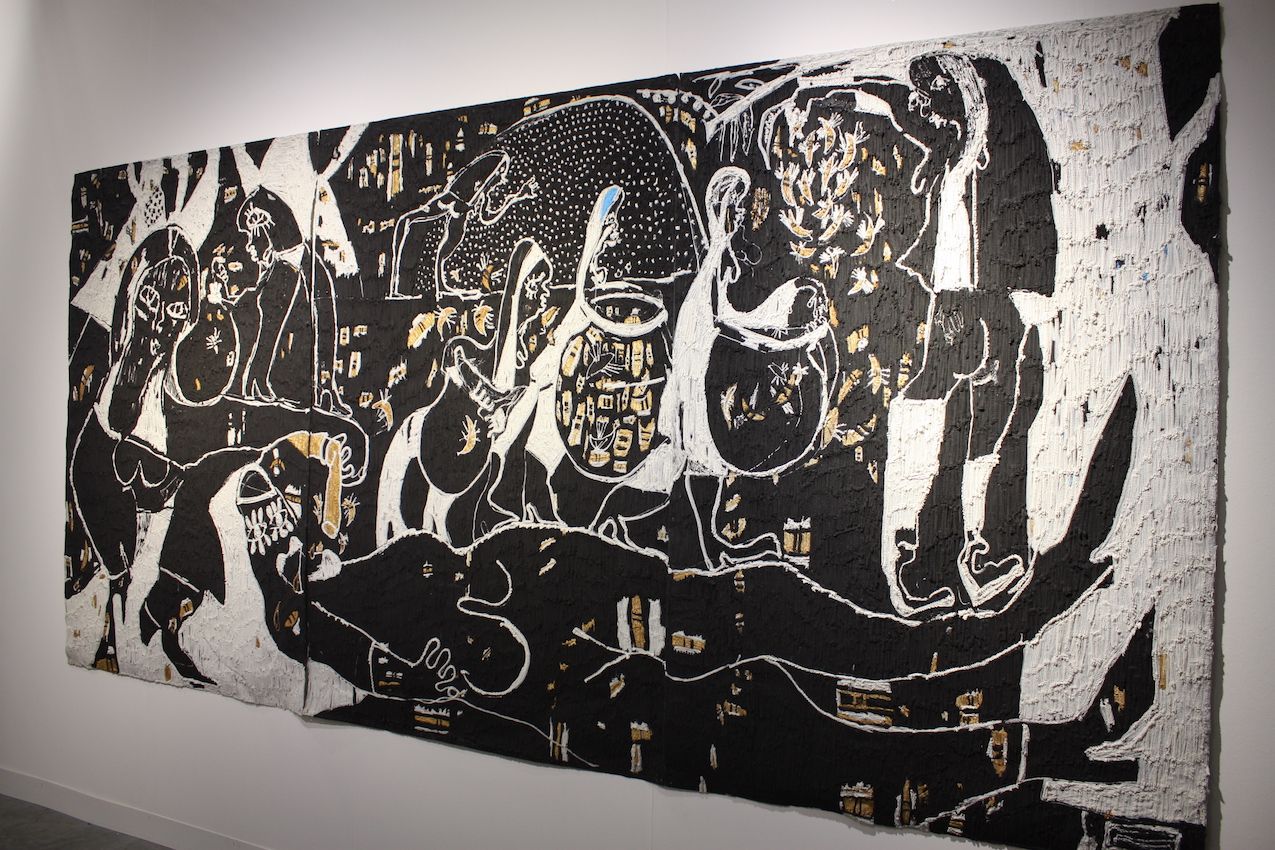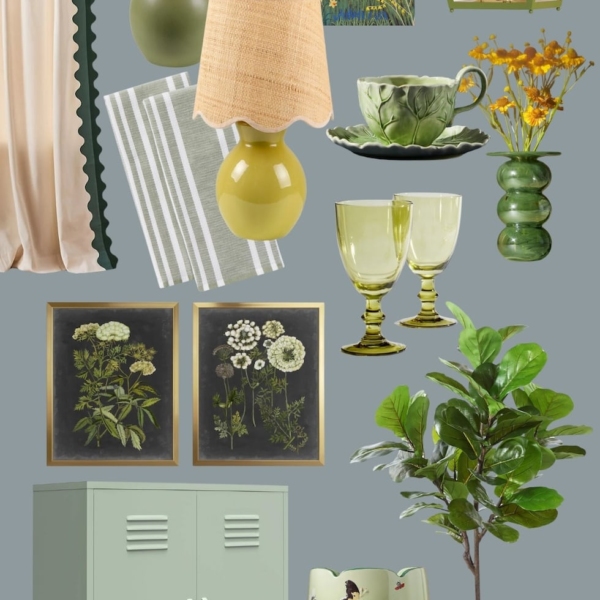Using unique wall art is one of the most interesting wall decor ideas that you can implement. More than just decorative elements, these wall decor ideas become a way to infuse your space with personality and style.
Whether it is a striking painting or 3D wall art, these pieces spark conversation, creating visually stunning focal points that draw and direct attention. Whatever the medium, these pieces allow you to bring new energy into your space and support emerging artists at the same time.
Look at these contributions from Miami Art Week to catch a glimpse of the best offerings.
Wall Decor Ideas
Each piece of wall art tells a unique story and inhabits a space differently. Consider all these options and think about ways that they could enhance your home.
Large-Scale Wall Decor

Incorporating a piece of massive wall art into your home decor can be a powerful and impactful wall design idea. Large works such as “Keeping Bees” by artist Summer Wheat. Wheat created this dramatic piece of wall art using acrylic paint on an aluminum mesh and a technique called impasto.
This technique allowed Wheat to create the highly textured surface that adds an earthy element to the canvas. Large-scale wall art creates a dramatic visual element that becomes the focal point of any room or wall. It elevates even the most unassuming interior spaces and reduces the need for additional wall art and decor.
Ombre-Inspired Wall Art

Ombre is a technique that involves blending colors seamlessly to create a gradient effect. “Homage to Fontana” by Nelson Leirner embraces this idea. He is a Brazilian artist and is known to embrace an eclectic and irreverent approach to art. Leirner uses warm colors to create an ombre-like transition in this piece. Wall art like this is an excellent way to bring color and vibrancy into a neutral contemporary space.
Surreal Wall Art

Surrealist art is characterized by its use of dreams and symbolic imagery. This small piece of wall art called “Gusanos y Carancoles” (Worms and Snails) by Bridget Bate Ticheinor embodies this dream-like style. Using surrealist wall art, even in small doses, can create a thought-provoking atmosphere in your space. This art has the ability to provoke strong emotion, so be ready to engage in lively conversations about the meaning of these pieces.
Eclectic Wall Decor

David Adamo, a contemporary artist from Rochester, N.Y., is well-known for his use of everyday materials to create and inspire his art. He often uses paper, metal, and wood and transforms these ordinary materials into fine art. For this “Untitled (eggs 14)” piece, he used acrylic and enamel on canvas to create this textured display. Adamo uses the simple form of eggs to transform this canvas into a vital and contemporary display.
Minimalist Wall Design

Minimalist wall art emphasizes simplicity, clean lines, and the reduction of unnecessary elements. Regardless of its simple style, minimalist wall art can have a dramatic impact as wall decor.
Lucio Fontana was an Argentinian artist who co-founded the movement called Spacialism. He created a series of wall arts featuring cuts or slashes. He envisioned that these cuts could break the surface of the art and allow the viewer to see beyond it. Pieces like this are not large, but they can still define the right area.
Textured Wall Design

Textured wall art is a way to add a visually interesting yet tactical dimension to your living area. This type of wall art can transform your walls to make them more engaging and dynamic.
Artists craft them from a variety of materials, including wood, metal, fabric, plastic, or a combination of materials. This type of wall art is excellent for walls that receive a high level of sun, as it creates a beautiful interplay between light and shadow.
Realistic Wall Art

Artists like Peter Cain were famous for combining the dreamieness of Surrealism with the style of photorealism, which is supremely realistic in design and execution. Cain’s most well-known works portray vintage and new cars in a unique way.
While this type of art would normally occupy masculine spaces, the collage-like nature of this work brings a deeper meaning to well-known objects. This makes them excellent options for general spaces where you want to display contemporary wall art.
Controversial Wall Art

Using wall art that has a controversial composition or meaning is a good way to spark debate or discussion. It often challenges conventional wisdom, which makes it a powerful addition to living spaces.
Controversial wall art, like this option from Roderigo Bueno, often addresses current cultural, political, or social views that make them relevant in contemporary spaces. Be sure to understand the meaning behind the creation of the wall art before you display it. This will ensure that you are a more educated and informed participant in the display.
Geometric Wall Art

Geometric wall art, such as this piece from Spanish sculptor Francisco Sobrino, gives any room a modern and sophisticated vibe. This piece, “Relacion N.B. 4” was created using black and white plexiglass.
He created objects that became dynamic because of the interplay of light and shadows. Geometric wall art also has a way of creating a sense of balance, symmetry, and precision in the space it occupies.
Popular Wall Art

Even the most common elements become elevated in Wayne Thiebaud’s popular-style wall art. The former Disney illustrator turned artist became well-known for his colorful depictions of everyday objects like ice cream, lipstick, pieces of pie, and paint cans. Thiebaud became known as a pop artist because of his fascination with these objects of everyday life. Pop art like his is a good way to give your space a contemporary or colorful edge.
Abstract Wall Art

Abstract art is a versatile and popular choice for wall design because it offers such a wide range of color possibilities and compositions. Like the untitled work from South African artist Zander Blom, abstract art emphasizes the use of colors, shapes, and forms without representing recognizable objects.
Three Dimensional Wall Art

Three dimensional wall is a way to add depth and dimension to the walls, and it also adds a sense of dynamic movement. Artists use unconventional items to make creative displays that allow them to customize the look and feel of the design. British artist Alice Channer used mussel shells to create her “Linear Bihalves.” This wall art combines organic and inorganic substances to create art that produces dynamic shadows along the wall.
Book Wall Decor

Books create their own statement when used on a shelf or as part of a bookcase composition. Books have textural and color interest, and they also provide a window into someone’s personality and tastes. This wall art uses books as its primary material.
It is called “Communistic Romance” by Theaster Gates from the University of Chicago. The eighty-three volume design and the lines of the narrative poem that are printed on the binding create a dramatic linear flow.
Statement Wall Design

Make your walls the focus of conversation with a statement piece such as the “Call Me Anything You Want” set from Paola Pivi. She used thousands of freshwater pearls attached to twenty canvases to create a discussion around the concepts of power, accumulation, and the ideas surrounding luxury. Statement wall decor can be simple in material, composition, and color but still define the space.
Reflective Wall Decor

Mosaic panels from Danish-Icelandic artist Olafur Eliasson utilize slivered pieces of hand-blown glass to create a vibrant reflective display. Like mirrors, reflective wall art works well in areas that benefit from more light. These objects reflect the natural and artificial light from other sources to create movement and light in dark spaces.
Thoughtful Wall Composition

This wall art from artist Teresita Hernandez features a map of the United States using scorched and broken fragments of charcoal. This composition is called “Fire (United States of America) 3.”
Her work seeks to explore ideas regarding the United States and its complicated history. This type of wall art not only provides a stunning visual display, but it is also a way to create a more meaningful atmosphere and one dedicated to the exploration of belief.
Dramatic Wall Design

Use a piece of wall art to create instant drama, such as this composition from American artist Jacob Hashimoto. He created “Garden of Cosmic Violence” using wood, acrylic, paper, and bamboo. This piece is not just texturally interesting; the colors and the use of diverse materials make it a dramatic wall statement that can work well to visually fill large walls.
Textile Wall Art

Use textiles such as quilts and tapestries to create colorful and textured wall displays. You can also think outside the standard textile options and consider textile wall sculptures like the one created by American artist Sheila Hicks. Hicks is known for her innovative and experimental weavings and textural art. Textile wall art often incorporates story and tradition, so this type of wall art is ideal for people who value traditional practices.
Activist Wall Decor

Activism inspires the work of American artist Andrea Bowers. Her piece titled “Called I’m a Feminist, What’s Your Superpower?” showcases her belief in the struggles of the women’s movement. Such pieces like this create dramatic wall decor and can provoke intense and thoughtful discussions with family and friends.
Conceptual Wall Art

Conceptual art emphasizes ideas and concepts over traditional aesthetic concerns like form, color, and composition. Conceptual wall art is a striking wall art decor idea because it challenges the viewer’s assumptions and beliefs about art itself. The Serbian artist Marina Abramovic created a video sequence called “Levitation of St. Teresa” to explore the juxtaposition between practical life and belief.


